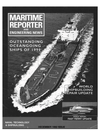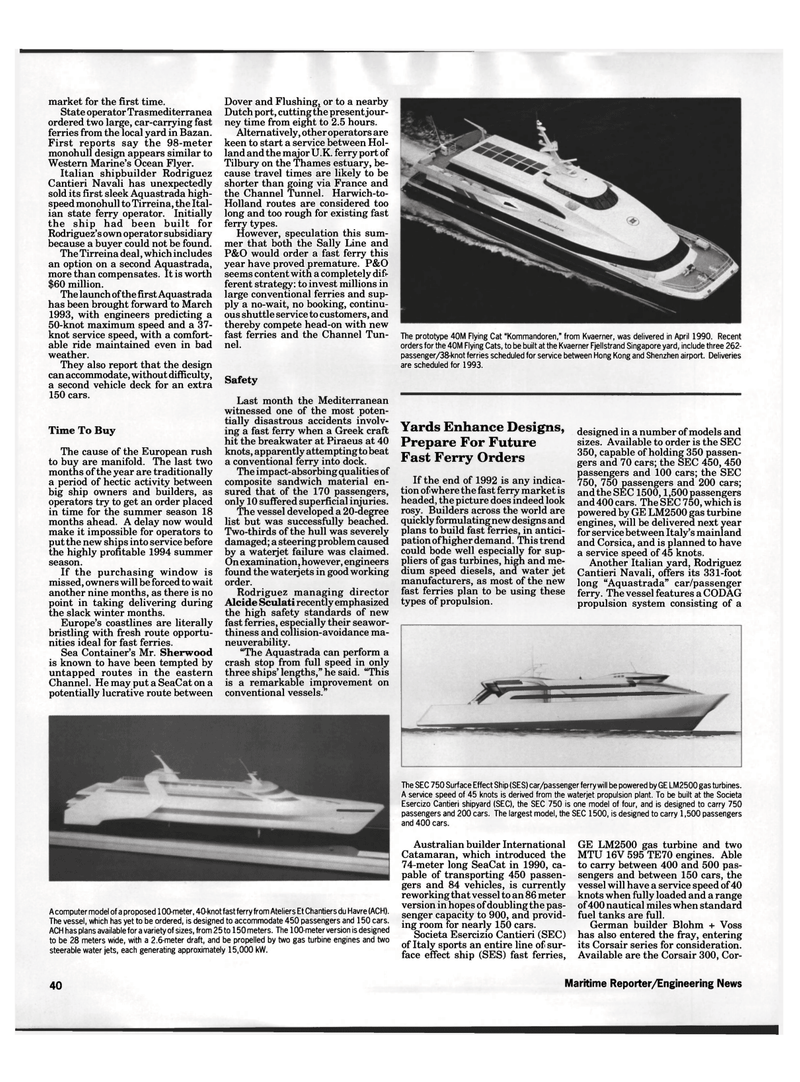
Page 38: of Maritime Reporter Magazine (December 1992)
Read this page in Pdf, Flash or Html5 edition of December 1992 Maritime Reporter Magazine
market for the first time.
State operator Trasmediterranea ordered two large, car-carrying fast ferries from the local yard in Bazan.
First reports say the 98-meter monohull design appears similar to
Western Marine's Ocean Flyer.
Italian shipbuilder Rodriguez
Cantieri Navali has unexpectedly sold its first sleek Aquastrada high- speed monohull to Tirreina, the Ital- ian state ferry operator. Initially the ship had been built for
Rodriguez's own operator subsidiary because a buyer could not be found.
The Tirreina deal, which includes an option on a second Aquastrada, more than compensates. It is worth $60 million.
The launch of the first Aquastrada has been brought forward to March 1993, with engineers predicting a 50-knot maximum speed and a 37- knot service speed, with a comfort- able ride maintained even in bad weather.
They also report that the design can accommodate, without difficulty, a second vehicle deck for an extra 150 cars.
Time To Buy
The cause of the European rush to buy are manifold. The last two months of the year are traditionally a period of hectic activity between big ship owners and builders, as operators try to get an order placed in time for the summer season 18 months ahead. A delay now would make it impossible for operators to put the new ships into service before the highly profitable 1994 summer season.
If the purchasing window is missed, owners will be forced to wait another nine months, as there is no point in taking delivering during the slack winter months.
Europe's coastlines are literally bristling with fresh route opportu- nities ideal for fast ferries.
Sea Container's Mr. Sherwood is known to have been tempted by untapped routes in the eastern
Channel. He may put a SeaCat on a potentially lucrative route between
Dover and Flushing, or to a nearby
Dutch port, cutting the present jour- ney time from eight to 2.5 hours.
Alternatively, other operators are keen to start a service between Hol- land and the major U.K. ferry port of
Tilbury on the Thames estuary, be- cause travel times are likely to be shorter than going via France and the Channel Tunnel. Harwich-to-
Holland routes are considered too long and too rough for existing fast ferry types.
However, speculation this sum- mer that both the Sally Line and
P&O would order a fast ferry this year have proved premature. P&O seems content with a completely dif- ferent strategy: to invest millions in large conventional ferries and sup- ply a no-wait, no booking, continu- ous shuttle service to customers, and thereby compete head-on with new fast ferries and the Channel Tun- nel.
Safety
Last month the Mediterranean witnessed one of the most poten- tially disastrous accidents involv- ing a fast ferry when a Greek craft hit the breakwater at Piraeus at 40 knots, apparently attempting to beat a conventional ferry into dock.
The impact-absorbing qualities of composite sandwich material en- sured that of the 170 passengers, only 10 suffered superficial injuries.
The vessel developed a 20-degree list but was successfully beached.
Two-thirds of the hull was severely damaged; a steering problem caused by a wateijet failure was claimed.
On examination, however, engineers found the wateijets in good working order.
Rodriguez managing director
Alcide Sculati recently emphasized the high safety standards of new fast ferries, especially their seawor- thiness and collision-avoidance ma- neuverability. "The Aquastrada can perform a crash stop from full speed in only three ships' lengths," he said. "This is a remarkable improvement on conventional vessels."
The prototype 40M Flying Cat "Kommandoren," from Kvaerner, was delivered in April 1990. Recent orders for the 40M Flying Cats, to be built at the Kvaerner Fjellstrand Singapore yard, include three 262- passenger/38-knot ferries scheduled for service between Hong Kong and Shenzhen airport. Deliveries are scheduled for 1993.
Yards Enhance Designs,
Prepare For Future
Fast Ferry Orders
If the end of 1992 is any indica- tion of where the fast ferry market is headed, the picture does indeed look rosy. Builders across the world are quickly formulating new designs and plans to build fast ferries, in antici- pation of higher demand. This trend could bode well especially for sup- pliers of gas turbines, high and me- dium speed diesels, and water jet manufacturers, as most of the new fast ferries plan to be using these types of propulsion. designed in a number of models and sizes. Available to order is the SEC 350, capable of holding 350 passen- gers and 70 cars; the SEC 450, 450 passengers and 100 cars; the SEC 750, 750 passengers and 200 cars; and the SEC 1500,1,500 passengers and 400 cars. The SEC 750, which is powered by GE LM2500 gas turbine engines, will be delivered next year for service between Italy's mainland and Corsica, and is planned to have a service speed of 45 knots.
Another Italian yard, Rodriguez
Cantieri Navali, offers its 331-foot long "Aquastrada" car/passenger ferry. The vessel features a CODAG propulsion system consisting of a
The SEC 750 Surface Effect Ship (SES) car/passenger ferry will be powered by GE LM2500 gas turbines.
A service speed of 45 knots is derived from the waterjet propulsion plant. To be built at the Societa
Esercizo Cantieri shipyard (SEC), the SEC 750 is one model of four, and is designed to carry 750 passengers and 200 cars. The largest model, the SEC 1500, is designed to carry 1,500 passengers and 400 cars.
Acomputermodelofaproposedl 00-meter, 40-knot fast ferry from Ateliers Et Chantiers du Havre (ACH).
The vessel, which has yet to be ordered, is designed to accommodate 450 passengers and 150 cars.
ACH has plans available for a variety of sizes, from 25 to 150 meters. The 100-meter version is designed to be 28 meters wide, with a 2.6-meter draft, and be propelled by two gas turbine engines and two steerable water jets, each generating approximately 15,000 kW.
Australian builder International
Catamaran, which introduced the 74-meter long SeaCat in 1990, ca- pable of transporting 450 passen- gers and 84 vehicles, is currently reworking that vessel to an 86 meter version in hopes of doubling the pas- senger capacity to 900, and provid- ing room for nearly 150 cars.
Societa Esercizio Cantieri (SEC) of Italy sports an entire line of sur- face effect ship (SES) fast ferries,
GE LM2500 gas turbine and two
MTU 16V 595 TE70 engines. Able to carry between 400 and 500 pas- sengers and between 150 cars, the vessel will have a service speed of 40 knots when fully loaded and a range of400 nautical miles when standard fuel tanks are full.
German builder Blohm + Voss has also entered the fray, entering its Corsair series for consideration.
Available are the Corsair 300, Cor- 40 Maritime Reporter/Engineering News

 37
37

 39
39
